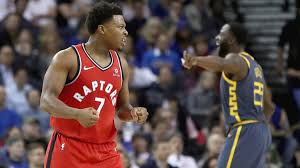By Colin W
The Oracle Arena crowd just kept waiting. Waiting for the Golden State Warriors, replete with a full cast of All-Stars, to make their run and cut into the Toronto Raptors’ commanding lead. Waiting for the consequences of not having Kawhi Leonard, one of the best two-way players in the NBA and a leading MVP candidate, to finally catch up to Toronto.
They waited as long as they could, all the way until they flooded the exits when both benches emptied with about five minutes left in the Raptors’ 113-93 embarrassment of the Warriors on their home floor on Wednesday, Toronto’s first win at Oracle Arena since 2004.
“We were just looking for one play, to turn the corner and turn it for you,” Kevin Durant said of the Warriors’ attempt to get back into the game. “We made a play, and then they made two or three plays, so you’ve got to give them credit.”
You can’t blame the Warriors for expecting their talent to eventually win out. They’ve used that patented third-quarter run to rip the hearts out of some of the best teams in the league in some of the most crucial situations, so why did it become an exercise in futility against a Raptors team whose best player was in street clothes with a hip injury?
Raptors coach Nick Nurse has a theory as to why his team has been nearly flawless in games without Leonard. They’re 7-1 after Wednesday’s win against the Warriors, and have won their last six Kawhi-less games — their only loss came in a road game on Oct. 29 against Toronto’s main challenger to the Eastern Conference crown so far, the Milwaukee Bucks.
There’s something different about the Raptors when Kawhi doesn’t play, a freedom and elegance to the way they move on offense. And so far, it’s produced masterful results.
“We’ve got to rely a little bit more on our offense to do the scoring, rather than individuals,” Nurse said of his team when Leonard sits out. “It could come from anywhere — anywhere from one to nine who gets into the game could go, and that’s just a product of the way we play offense. It makes us a little more unpredictable, harder to guard sometimes.”
Yes, Nick Nurse, head coach of the Toronto Raptors, said that his team is occasionally harder to guard when Kawhi Leonard, who averages 26.1 points per game, isn’t on the floor. That’s not exactly conventional thinking when a player of Leonard’s caliber is subtracted from an offense. Just look at what happens when Stephen Curry misses extended time for the Warriors — the offense falls off a cliff.
Nurse is a smart guy, though, and the numbers back up his assertion. The Raptors have averaged 119.1 points per game when Kawhi sits, compared to their average of 115.6 for the season, and it’s not as simple as Kyle Lowry, the team’s other All-Star, picking up the slack — though he has been brilliant (Nurse said part of what makes Lowry an All-Star is his ability to figure out when to assert himself and take over games). When Curry is out, for example, Kevin Durant and Klay Thompson pick up the bulk of the scoring load. When Kawhi sits, however, the wealth is distributed across the deep Toronto roster.
Five players scored in double figures in the win over the Warriors. In the previous night’s win over the Clippers, six players cracked the 10-point threshold. Against the Hawks, the Raptors had four players with 19 or more points. You get the point.
The Raptors regularly have multiple players in double figures, so it can’t all be attributed to Kawhi’s absence, but the way in which they get their buckets changes. Part of the difference is that a lot of Leonard’s scoring possessions come out of isolation, giving the Raptors 253 isolation possessions this season, according to Synergy Sports Technology, good for eighth in the NBA (by the way, the Houston Rockets have a whopping 501 iso possessions so far, pretty much lapping the competition like Katie Ledecky at a swim meet).
For Leonard himself, 18.8 percent of his scoring opportunities come out of isolation, sixth in the NBA (yep, you guessed it — James Harden at 45.5 percent and Chris Paul at 30.5 percent top the list). As Nurse said, Kawhi going into repeated isolations can get a bit predictable, so it’s not hard to understand why the ball moves more freely when Leonard is on the sideline. The Raptors average 25.4 assists for the season, and have dished out 28 per game in the eight contests without Leonard.
Here’s a typical Leonard iso possession, where he hunts the matchup he wants, in this case Larry Nance Jr., and goes into a series of moves while seconds tick off the clock and teammates stand around watching.
Of course he makes the shot — because Kawhi is amazing — but contrast that possession to this beautiful multi-cutter, multi-screen, confusion-inducing action the Raptors ran on Wednesday against the Warriors that resulted in a Serge Ibaka jump hook from his sweet spot (and Durant frustratingly firing the ball off the stanchion).
If the defense had collapsed a bit further on Ibaka, he also had Danny Green and CJ Miles — two excellent shooters — wide open for 3s. Both plays resulted in baskets, but you can see how the second style might be more appealing to role players.
Throwing the numbers out for a second, there’s also the good old-fashioned notion that players tend to step up when a star is out. Warriors coach Steve Kerr admitted he doesn’t know the intricacies of the Raptors offense, but has plenty of experience with star players missing time and role players being thrust into the spotlight.
“I just think sometimes when your best player is out, it gives the other players more license to play, to play with some freedom and to be aggressive,” Kerr said. “I’ve seen it an awful lot, so it didn’t surprise me how well the other [Raptors] played. They have a lot of good players.”
Given the way the Raptors, back in action on Friday against the Blazers (10 p.m. ET — watch on fuboTV with the NBA League Pass extension), have performed this season without Leonard, it’s easy to see why they felt comfortable — even in the harsh Oracle environs.
“Tonight, they were obviously the better team,” Curry said after the loss. “Everybody seemed to have confidence and were playing off each other really well.”
This is not to suggest, in any way shape or form, that the Raptors are a better team without Leonard. They’ve had a couple of big wins over the last two games, plus back-to-back road victories against the Lakers and Jazz in early November, but they’ve also beaten the lowly Hawks, Bulls and Wizards without Leonard’s services.
Toronto will undoubtedly need Kawhi on the floor come playoff time, when the game often devolves into isolation during crunch time as favorable matchups are repeatedly created through switches, and then exploited. Leonard is third in the NBA in “clutch” scoring (defined as a game within five points with less than five minutes remaining), shooting 51 percent from the field in those situations according to NBA.com. Having a proven go-to scorer, even if he doesn’t always play within the flow of the offense, can be the difference between a championship and a painful early playoff exit, as the Raptors know all too well.
And, of course, we can’t talk about Kawhi Leonard without talking about defense. The Raptors have been good without him, but they’ll need perhaps the league’s best perimeter defender when they take on the tremendous individual talents the Eastern Conference playoffs, and eventually the NBA Finals if they get that far, will present.
“The one thing we really miss is [Leonard’s] versatility on defense,” Nurse said. “It seems we’re in a little bit more mismatched situations — sometimes we’re too small, sometimes we’re too big — and with him we’re kind of just right.




